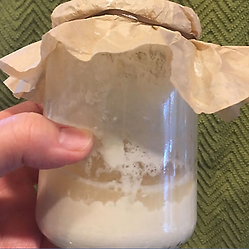How I Make Sourdough Bread
Sourdough is a slow-fermented bread without yeast that acts as a prebiotic to help maintain a stable, healthy digestive system.

Sourdough Starter
-
After looking through several library books, I saw this one on Amazon—cheap, a pamphlet really. It was the best book I found for simple sourdough.
-
I followed his instructions for making the starter — it's just flour and water left out on the counter until it picks up yeasts from the air and becomes bubbly. I had success on the first try and have kept it going for years.
-
I am happy to share my starter with anyone who wants to stop by my house.

Storing the Starter
-
To store the starter between bakings...
-
Keep the flour and water in a jar, with an unbleached coffee filter on top held on with a rubber band. This allows air to get in and keeps other "stuff" out.
-
Place the covered jar in the refrigerator.
-
If a black liquid forms on top, simply pour it off, or if there isn't much just stir it into the starter and consider it more yeast.

Waking Up the Starter
-
When ready to make some bread...
-
Remove the starter from the refrigerator and let it warm to room temperature for a few hours.
-
Pour the entire contents into a clean bowl, add a cup or two more flour and water.
-
Let it sit a few more hours (or overnight) until it gets bubbly, as pictured.
-
Remove about a half cup of this fresh starter, put it back in the jar, add a bit more water and flour, secure coffee filter with rubber band, and put into the refrigerator to use the next time.

Making Dough
The simplest sourdough...
-
Water, flour, and 1 tsp salt per loaf.
-
My large Tupperware bowl shown above is filled with water about ¼ full, the salt added, and some flour continuously added until it is no longer able to be stirred.
-
The dough is kneaded right in the bowl to avoid a mess on the counter.
-
Flour is added while kneading until it doesn't stick to fingers anymore, but not as dense as regular yeast-raised bread dough.
-
The bowl is covered with a towel and set aside at room temperature until dough doubles in size.

Optional Additions
-
Honey, molasses, or another sweetener (makes it rise faster).
-
An egg or two.
-
Fat of some sort, such as ghee or olive oil.
-
Other flours such as rye, whole wheat, whatever. (Our local co-op has a flour blend for making a multi-seed bread that is very tasty with this bread.)
-
Seasonings, spices, cheese, raisins, dried fruits, seeds... go nuts! (Oh yeah, you can add nuts!)

Ready to Bake
-
The dough is ready to be put in a pan...
-
This amount makes 2 loaves for me.
-
I bake it in a bread loaf pan, so I can easily cut it for toasting in my toaster, but you could easily form and bake it in the typical sourdough style.
-
Preheat oven to 350 degrees F.
-
Bake for 30 to 35 minutes or until it sounds hollow when tapped.
-
Let cool a bit and then dig in!
-
When making bread, I sometimes make a small batch of cinnamon rolls with some of the dough

Finished Product
As shown here, the final product has a very good texture. Exceptional for French toast! It typically takes 2 days, from removing the starter from the refrigerator until the loaves are baked and ready to eat.